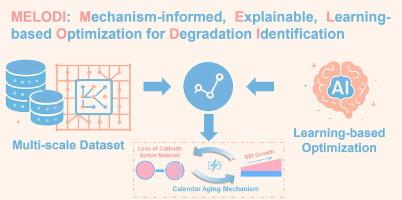MELODI:一种可解释的机器学习方法,用于机械解决电池日历老化问题
IF 14.9
1区 化学
Q1 Energy
引用次数: 0
摘要
锂离子电池(lib)被广泛应用,从电网规模的存储到电动汽车。lib在其大部分使用寿命中保持静止,日历老化会降低容量。了解LIB日历老化机制对于延长电池寿命至关重要。然而,LIB日历老化受到多种因素的影响,包括电池材料、电池状态和储存环境。日历老化实验也很耗时、昂贵,而且缺乏标准化的测试条件。本研究采用数据驱动的方法建立了链接lib材料、副反应机制和日历老化的跨尺度数据库。MELODI (Mechanism-informed, Explainable, Learning-based Optimization for Degradation Identification)用于识别日历老化机制,并量化多尺度因素的影响。结果表明,在高镍(Ni)电池中,正极材料损耗占91.42%,而在磷酸铁锂(LFP)电池和低镍电池中,固态电解质界面生长占主导地位,分别占82.43%和99.10%。本研究系统地量化了商用lib在不同材料、电荷状态和温度下的日历老化。这些发现为实验设计或电池使用提供了定量指导,并对航空机器人、车辆到电网和嵌入式智能系统等新兴应用产生了影响。本文章由计算机程序翻译,如有差异,请以英文原文为准。

MELODI: An explainable machine learning method for mechanistic disentanglement of battery calendar aging
Lithium-ion batteries (LIBs) are widely deployed, from grid-scale storage to electric vehicles. LIBs remain stationary most of their service life, where calendar aging degrades capacity. Understanding the mechanisms of LIB calendar aging is crucial for extending battery lifespan. However, LIB calendar aging is influenced by multiple factors, including battery material, its state, and storage environment. Calendar aging experiments are also time-consuming, costly, and lack standardized testing conditions. This study employs a data-driven approach to establish a cross-scale database linking materials, side-reaction mechanisms, and calendar aging of LIBs. MELODI (Mechanism-informed, Explainable, Learning-based Optimization for Degradation Identification) is proposed to identify calendar aging mechanisms and quantify the effects of multi-scale factors. Results reveal that cathode material loss drives up to 91.42 % of calendar aging degradation in high-nickel (Ni) batteries, while solid electrolyte interphase growth dominates in lithium iron phosphate (LFP) and low-Ni batteries, contributing up to 82.43 % of degradation in LFP batteries and 99.10 % of decay in low-Ni batteries, respectively. This study systematically quantifies calendar aging in commercial LIBs under varying materials, states of charge, and temperatures. These findings offer quantitative guidance for experimental design or battery use, and implications for emerging applications like aerial robotics, vehicle-to-grid, and embodied intelligence systems.
求助全文
通过发布文献求助,成功后即可免费获取论文全文。
去求助
来源期刊

Journal of Energy Chemistry
CHEMISTRY, APPLIED-CHEMISTRY, PHYSICAL
CiteScore
19.10
自引率
8.40%
发文量
3631
审稿时长
15 days
期刊介绍:
The Journal of Energy Chemistry, the official publication of Science Press and the Dalian Institute of Chemical Physics, Chinese Academy of Sciences, serves as a platform for reporting creative research and innovative applications in energy chemistry. It mainly reports on creative researches and innovative applications of chemical conversions of fossil energy, carbon dioxide, electrochemical energy and hydrogen energy, as well as the conversions of biomass and solar energy related with chemical issues to promote academic exchanges in the field of energy chemistry and to accelerate the exploration, research and development of energy science and technologies.
This journal focuses on original research papers covering various topics within energy chemistry worldwide, including:
Optimized utilization of fossil energy
Hydrogen energy
Conversion and storage of electrochemical energy
Capture, storage, and chemical conversion of carbon dioxide
Materials and nanotechnologies for energy conversion and storage
Chemistry in biomass conversion
Chemistry in the utilization of solar energy
 求助内容:
求助内容: 应助结果提醒方式:
应助结果提醒方式:


